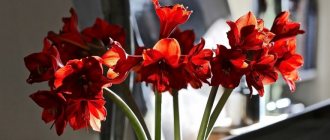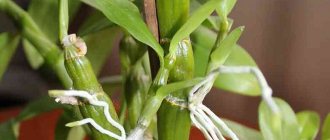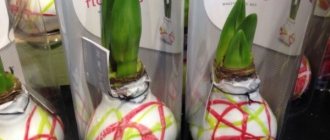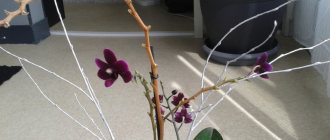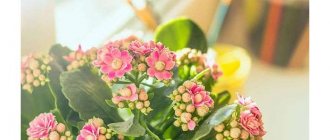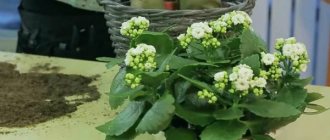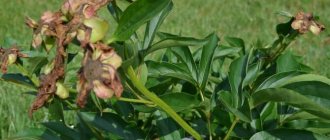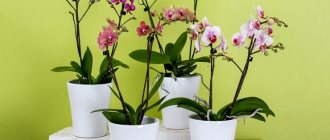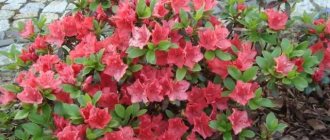Hyacinths bloom beautifully and look great in a pot, but the question often arises of what to do with hyacinths after flowering.
Dear readers! For you, we have created communities on social networks in which useful articles and interesting ideas are published several times a day! Subscribe and receive useful content in a convenient format!
The simplest option for what you can do is to throw out the bulb, but it is much nicer to give the flower a second life.
We will tell you in today's article what actions need to be performed with the flower after all the petals have fallen.
Where to start caring for hyacinth in a pot after flowering
If you provide the hyacinth with proper care, then there is a high probability that you will soon be able to see the flowering process again.
First of all, you should try to save the rhizome (but not the plant itself above the ground) by carrying out simple actions after flowering.
As soon as the hyacinth has faded, it, along with the fading leaves, must be taken out of the store container and shaken with an earthen ball. In this case, you should pay attention to the appearance of the bulb and its bottom in order to recognize rotting.
Then you need to separate the bottom part.
How does it bloom?
The herbaceous perennial reaches a height of 20-40 centimeters. bell-shaped flowers bloom on it , collected in spike-shaped brushes called sultans.
The flowering process is accompanied by:
- emitting a subtle aroma;
- the formation of short pedicels;
- the formation of a fleshy fruit capsule of a spherical shape.
The inflorescences come in different colors: blue and dark blue, purple and lilac, white and yellow, red and pink, cream and even black.
Step-by-step instructions for caring for hyacinth at home
To revive hyacinth and continue to enjoy its blooms, you must follow certain recommendations. The first method includes the following steps:
- As soon as flowering has stopped, do the following: cut off the peduncle (leaving about 12 cm), leave the leaves.
- Watering should be gradually reduced to a minimum. It is necessary to water only when the soil dries out. But watering should not be as abundant as with a flowering plant, but with longer breaks.
- Over time, the leaves will turn yellow. Carefully complete watering and wait until the leaves are completely dry.
- Once the leaves are dry, they should be trimmed and the bulbs removed. When removing the head from the pot, you must be careful and free it from the soil.
- It is recommended to dry the bulb in a warm, dry and ventilated area. Thus, planting material should be stored until the next planting. For this purpose, you can choose a cardboard box or other container, but not in film.
Before sending the bulbs to dry, it is recommended to process them. Doing this in the refrigerator is prohibited.
The second way to care for faded hyacinth:
- Peduncles with faded flowers are cut off. There is no need to do too much pruning; it is recommended to leave about 12 cm. The leaves should dry out on their own. The plant should smoothly enter the dormant phase.
- Now you need to move the plant to a larger container. The earthen lump must be left behind. In such conditions, the bulbs will develop on their own, and young plants will appear next to them.
- The plant should be left in a bright and ventilated area. After transplantation, hyacinth should be watered in doses. There is an opinion that this must be done through a pallet. A couple of weeks after transplanting, you can add some fertilizer to the soil.
- Now you need to decide: the plant will remain in a pot on the windowsill, or it will migrate to open soil in the garden bed.
- When the leaves are completely dry, stop watering. The bulb is freed from the soil, cleaned, dried and stored until it is time to plant it in the ground.
- Storage is allowed in the pantry or under a cabinet. The storage location should be dark and not hot. The bulbs can be stored for up to three months.
Hyacinth plant: legends and beliefs
reproductions of paintings-stories about the origin of hyacinths
A number of legends are associated with hyacinths, for example:
- about the handsome young man Hyakinthos, at the site of whose death this flower grew. Apollo was in love with the young man, but the jealous Zephyr, the god of the west wind, mortally wounded Hyakynthos during a discus throwing exercise. The name of the flower that appeared at the site of death was given by Apollo himself;
- about Hyacinth's injury. In ancient Greek society, a person bearing this name was popular and revered. But over time, his glory faded, the god of beauty Apollo eclipsed him. One day they began to compete in discus throwing. Apollo wounded Hyacinth and from the drops of the second’s blood that fell to the ground, scarlet hyacinths sprouted;
- about the appearance of flowers off the coast of Holland. A week after the shipwreck, the children saw flowers and leaves swaying in the surf along the shore. These were hyacinths;
- associated with Ajax's suicide. After the death of Achilles, Odysseus and Ajax laid claim to his weapons. The Council of Elders gave preference to Odysseus. Ajax was amazed at their decision and pierced himself with a sword. Hyacinths grew at the site of his death.
There are also beliefs associated with hyacinths. For example, one of them says that ancient Greek women loved to decorate their hair with them. This is how they attracted happiness and love to themselves, learned how to curl and style their locks beautifully.
How to care for a plant when it has bloomed
If we talk about planting in the ground, then it is permissible to leave the bulbs in the ground in one place for five years in a row. After this time, they will become larger, and they can be dug up and planted with children.
But experienced gardeners advise not to leave flowers in the ground for many months, since after winter they may stop blooming. It is recommended to remove the bulbs, sort, inspect, disinfect and store in a cool and dark place.
Digged or purchased bulbs must first be dried. This should be done indoors at a temperature of about +23 degrees. After this, they need to be shaken off the ground and the unnecessary husks removed. If small onions appear, they should be separated carefully.
After this, the bulbs are distributed in a cooler place. In this case, the temperature should gradually decrease. By the end of summer, the bulbs should be stored at a temperature no higher than +18 degrees.
There should not be high humidity in the room; good ventilation should be provided. At the end of summer, the bulbs are planted in the ground for the winter.
Why do hyacinths not bloom or bloom poorly?
short-pedunculated hyacinth
There are several main reasons for this:
- bulb. It could have entered the soil already diseased or damaged,
- storage. Namely, failure to comply with all rules, poor quality air humidification in the room,
- landing. Too early or late, to a greater or lesser depth,
- priming. Excessively hard and dry or sour and wet, with the presence of weeds during planting and budding,
- wrong choice of landing site. For example, the soil on which other bulbous plants grew last year is infected with diseases/pests and is dangerous for hyacinths,
- lack of watering and sunlight in the required amount.
Care in open areas
Now let's talk about what to do with hyacinths after flowering if they grow right in your open ground.
After the hyacinth has been planted in the ground, it must be regularly weeded, watered, fertilized and loosened. It must be borne in mind that hyacinths do not like weeds. As soon as sprouts begin to appear, you need to start fertilizing the soil. It is better to give preference to saltpeter (27 grams per 1 square meter).
You should fertilize the soil again when the buds appear. The spaces between flowers in one row or between rows are fertilized. After fertilizing has been applied, it is necessary to water the crops.
The flowering period of hyacinths quickly ends, and after it it is necessary to continue to moisturize the root system. In order for the bulbs to become stronger after flowering, you must continue to fertilize and water regularly.
Transplanting hyacinths in spring
Although it is customary to plant hyacinths in the ground in the autumn months, this can also be done in the spring if necessary. Some gardeners consider the spring months to be the most preferable period for planting hyacinths. They wait until the threat of frost has passed and get to work.
In order for the plant to produce flowers in the same year, the bulbs should be kept in the freezer for an hour before planting. There is no need to increase this time. The soil also needs to be prepared in advance. To prevent it from being washed away by rain, the soil is covered with thin plywood, leaves, and spruce branches.
It is recommended to carry out preparatory work in advance. If hyacinths are planned to be planted in the spring, then you can work on the soil as early as August. It can be fed with rotted manure or complex mineral fertilizers. And in order for the transplanted plants to bloom profusely, it is advisable to add potassium fertilizers, superphosphate, and magnesium sulfate to the soil. Potassium can be replaced with ash, magnesium with dolomite flour.
Before transplanting, the bulbs are inspected for wounds and other damage. Only healthy tubers are resistant to adverse weather conditions. The bulbs are deepened by about 15 cm. You can add a little river sand to the hole before planting. This helps protect the plant from excessive moisture and infections.
All articles about hyacinths on the site can be read by following this link...
Hyacinths can be replanted and grown both in flower pots and in open ground. With proper care and careful attention, these plants will reward you with beautiful flowering and rich aroma, transform any corner of the garden, window sill or balcony and will delight you with bright colors for a long time.
How to restore hyacinth after forcing
When a crop is grown and forced to bloom at the end of winter, this is called forcing. At the same time, the hyacinth weakens, and the plant requires a lot of strength.
IMPORTANT! The gardener must slowly put the flower into a dormant state so that the head gets stronger and new buds form for flowering.
You need to trim the peduncle with a sharp knife, previously disinfected. Then you need to remove the hyacinth from the pot along with the soil without damaging the roots.
Now the bulbous rhizomes need to be dried in a dark and cool place until the end of summer. It is strictly not recommended to plant the crop in any container at home.
Hyacinth should get stronger after forcing. It will bloom again in a year or two in open areas.
Bulb storage
Hyacinth is planted in September in an open area. But what to do with the onion until this time? Proper storage will ensure abundant flowering in the spring.
Hyocinth bulb
- The bulb is dried in fresh air at a temperature of 20-22 ºС until all the leaves dry out.
- Free from soil residues, remove old scales.
- Disinfect in a weak solution of potassium permanganate.
- The kids disconnect. Keep in mind that in varietal hyacinths the characteristics are preserved during vegetative propagation.
- It is better to keep large bulbs separately from others, as they are less susceptible to disease.
- Store in a dark, cool place.
Is it worth digging up hyacinth bulbs for the winter?
It is imperative to dig up these crops for the winter. There are several reasons for this:
- Their shell is too thin and does not protect against excessive moisture. Even normal precipitation can lead to rotting of the crop.
- Rodents love to eat these plants.
- Even if the plant overwinters, the second flowering will be sparse, and the crop itself will become weakened.
Water hyacinth for aquarium for water purification
water hyacinth in a natural pond
Eichornia, or water hyacinth, loves water in different forms:
- vase
- pond
- aquarium
Its roots quickly remove turbidity and attract harmful salts that have already dissolved in the water. This ability is extremely valuable for maintaining a harmonious environment in the aquarium. Due to frequent additions of water, you add new substances that are not beneficial for its inhabitants.
Above the aquarium where the eichornia lives, be sure to install a lamp at a height of 40 cm so that the leaves receive enough light.
So, we looked at the features of growing hyacinths in the open ground and in a pot, and its useful properties for cleaning water bodies. We got acquainted with the process of their reproduction and care.
Buy yourself this amazingly fragrant flower and make friends with it!
How to plant hyacinth in the fall after flowering
Hyacinths should be planted no earlier than the end of September.
IMPORTANT! For these flowers, you need to choose an area where the sun falls. There is no need to plant the crop under any seedlings, since in this case they will not have enough valuable substances for development.
The soil should be nutritious and loosened. A small amount of sand should be poured into each hole for planting material. After planting the bulbs, they need to be sprinkled with soil and fertilizers. If the depressions were wet, then there is no need to water the crops after planting.
Growing in open ground
At the dacha, bulbous plants are given sunny areas. They do not like close groundwater and acidic soil. Select an area with neutral soil high in nutrients. However, organic fertilizers in the form of manure cannot be applied before planting.
On a note! For growing, you can set aside a corner under fruit trees. Early in the spring they will have enough light; later, the blossoming foliage will protect them from the wind.
The hyacinths have bloomed in the garden; what to do next is the main question for novice gardeners. During the growing season, nutrients are consumed from the bulb. At the end of the season, she needs time to recover. If there is no food, you may not see beautiful buds next year. After all, only one peduncle grows from each uterus.
What not to do after hyacinths bloom
After hyacinths bloom, you cannot immediately plant them in the ground and leave them there until next year. They will not survive with such actions.
You should also not dig up crops after heavy rainfall or during hot weather.
IMPORTANT! If the plant is overtaken by disease or has too much moisture, the leaves begin to turn yellow. It is necessary to stop watering, dig up the plant along with the soil, move it to a wooden container and leave it in a ventilated area.
Diseases and pests
Like any plants, hyacinths are subject to various diseases or pest attacks.
Yellow bacterial rot
During this disease, the bulb liquefies. An unpleasant odor begins to emanate from it, and the plant stops growing. The onset of the disease can be recognized by the gray spots that appear on the leaves.
Parasitic blossom end rot
The disease is caused by pathogenic microorganisms found in contaminated soil. Small brown depressions appear on the flowers and leaves of the plant, the tips of the leaves become thinner and destroyed, and the roots rot.
Mosaic
Chaotically located elongated light green spots appear on the leaves and flowers. The affected areas begin to turn yellow and dry out. The plant slows down its growth and may die.
Gray rot
Most often it affects plants during the period of early growth. Yellow spots form on the plant, which gradually increase in size and become brown in color. The disease quickly affects the roots and the plant dies.
Pests
The main pests of hyacinths are aphids, spider mites, nematodes, flower flies and mole crickets. Plants become depleted, leaves turn yellow and wither, buds fall off. If pests are not noticed in time, they can destroy the plant.
Insecticides, which are sold at any garden store, help in controlling pests.
Answers to frequently asked questions
Let's look at the most frequently asked questions:
Why doesn't hyacinth bloom?
You need to pay attention to the soil. For example, it may be too wet or not fertilized enough. Poor watering also adversely affects flowering.
What to do with plant babies?
They need to be carefully separated from the older bulbs and dried. After this, you can plant it in another pot or in open ground.
How to get big flowers?
In order for the children to be of good size, it is necessary to loosen and hill up the soil. This will be an additional barrier from the scorching sun on hot days.
When is the best time to transplant?
It is recommended to do this at the end of September. Plants need to take root before cold weather. If you do this at the end of October, for example, then the crop will not have time to sprout a sufficient number of roots, which means it may die in the winter months.
When is the best time to dig up hyacinths?
This can be done when flowering has ended, the leaves have turned yellow, and from early to mid-summer.
When should you dig hyacinths out of the ground?
This should be done as soon as the leaves begin to turn yellow. Otherwise, the leaves will turn yellow, dry out and fly away due to the wind. In this case, the heads are difficult to find.
When do hyacinths sprout, when do they bloom, how many times do they bloom?
blooming hyacinths of different shades
Hyacinths bloom only once a year. During this period, their bulbs are so depleted that they are no longer able to please with beautiful flowers.
Plants living in open ground bloom in the spring with the arrival of the first warmth and rain. The end of March and the beginning of April are their months.
Indoor hyacinths are ready to bloom at the time you choose. Of course, pay attention to their varieties before planting. That’s why they bloom in:
- end of December
- January-February
- first spring months
